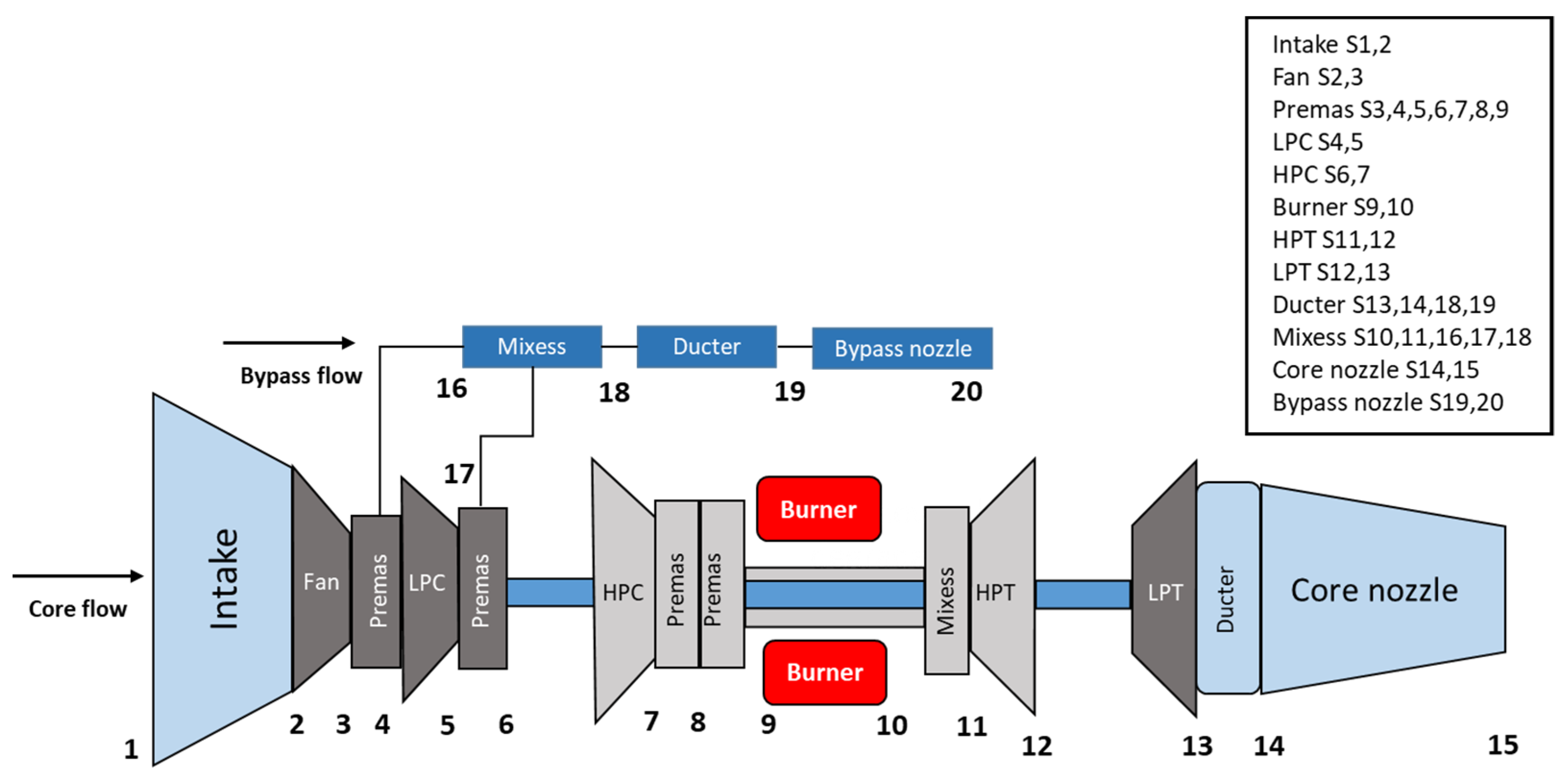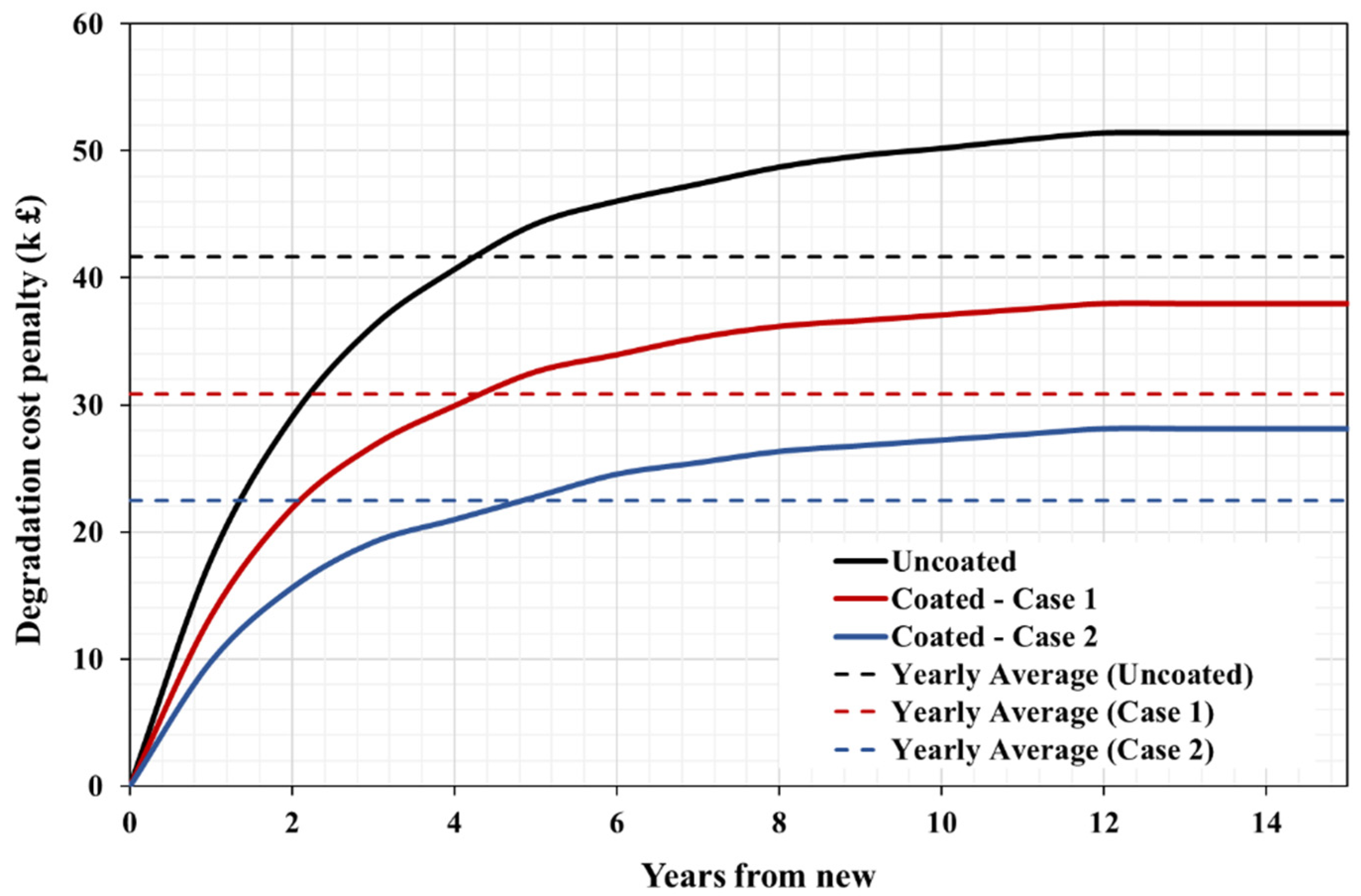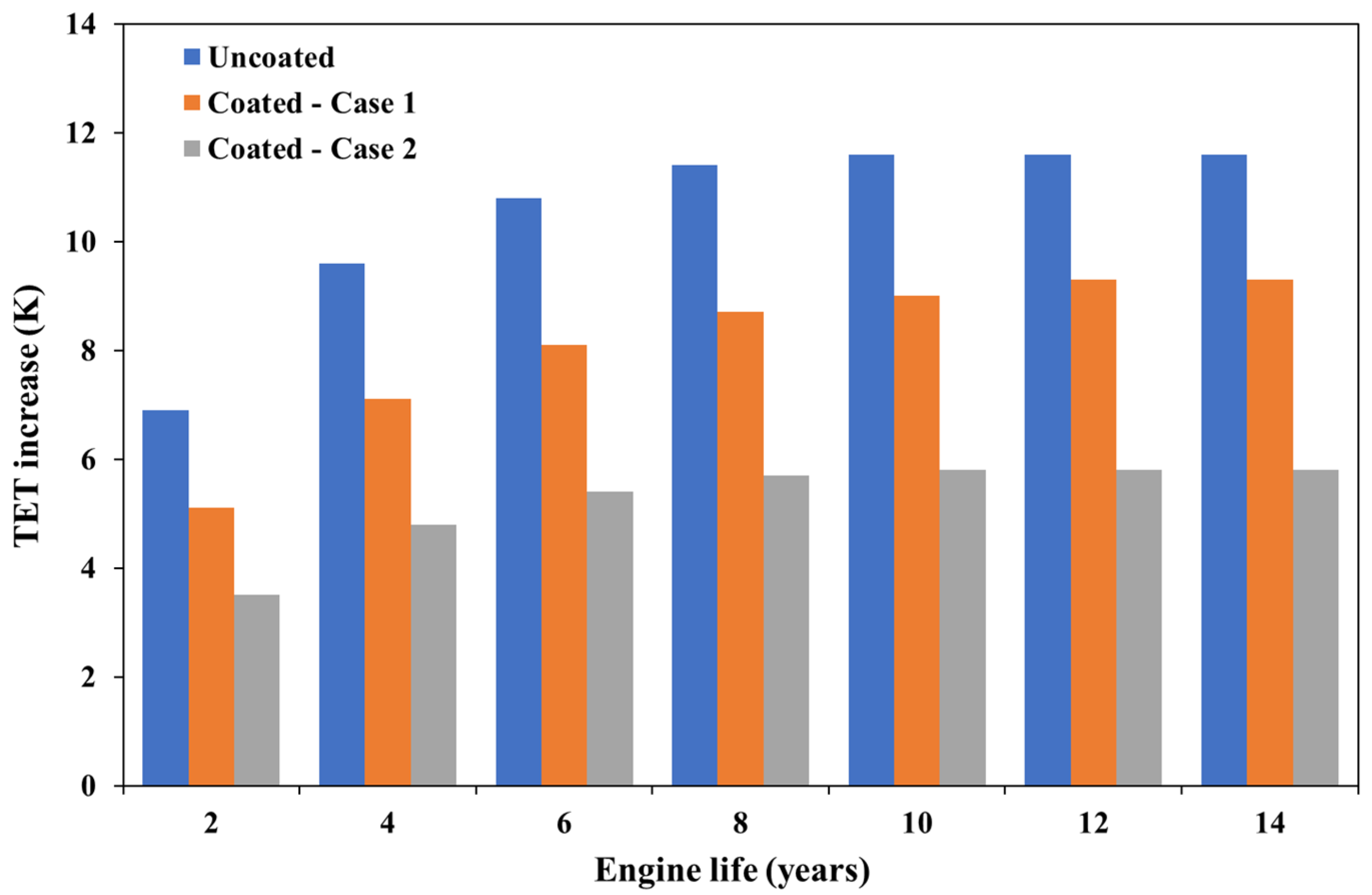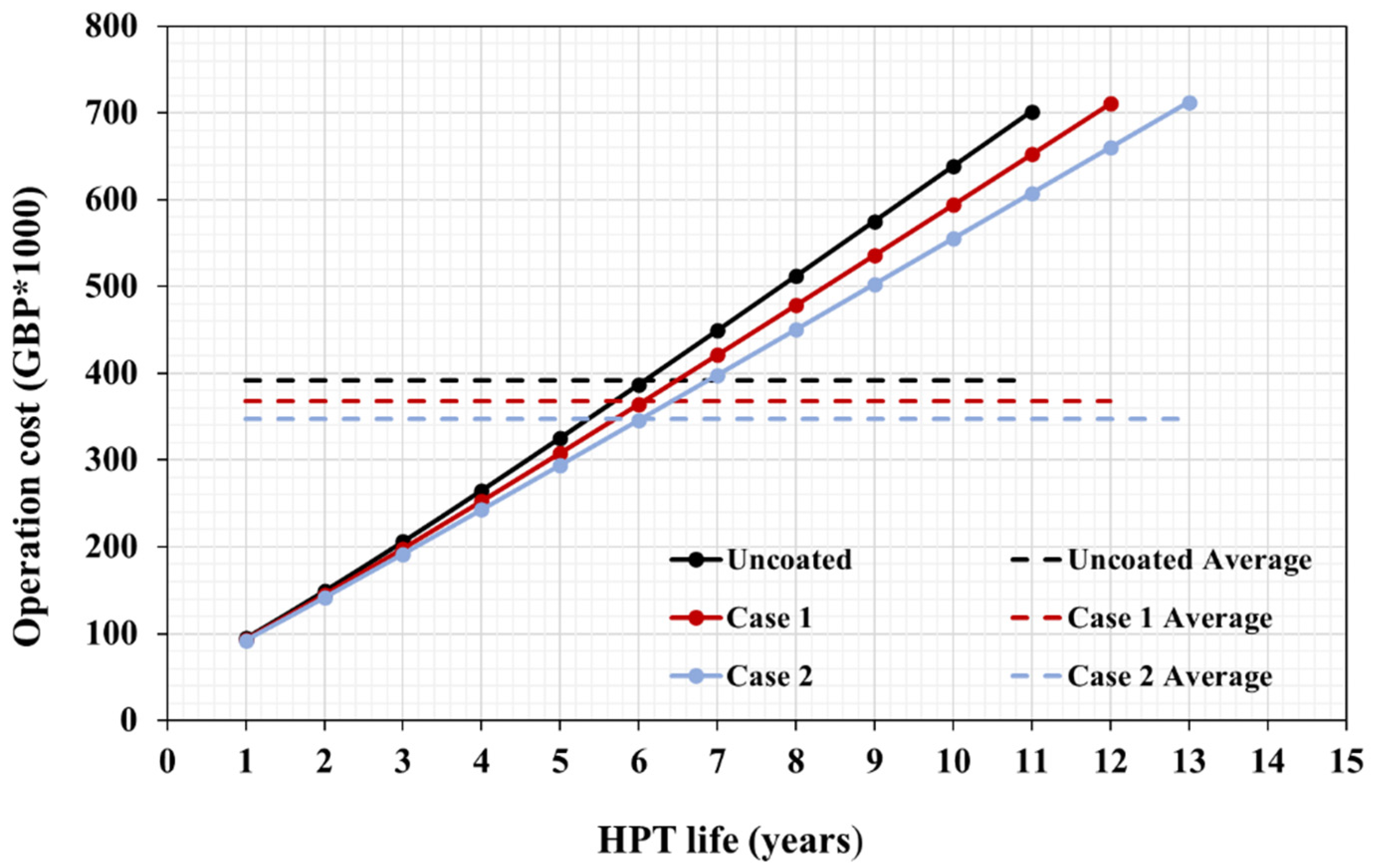Quantifying the Economic Benefits of Using Erosion Protective Coatings in a Low-Pressure Compressor (Aero-Engine): A Case Study Evaluation
Abstract
1. Introduction
1.1. Background
1.2. Benefits of Utilising EPC Techniques
1.3. Aim of the Study
2. Methodology
2.1. Cost Benefit Analysis (CBA)
- Defining project choices to be evaluated.
- Deciding which costs and benefits are to be counted.
- Selecting suitable measures and measuring of relevant benefits and costs.
- Estimating outcomes of benefits and costs during an appropriate period of time.
- Converting all benefits and costs into a common currency.
- Calculating the NPV for each project options.
- Carrying out sensitivity analyses.
- Providing recommendations based on the NPV and sensitivity analyses.
2.2. Turbomatch Performance Tool
2.3. Case Study Details
2.4. Assumptions
3. Data Collection and Calculations
3.1. Calculated Costs
3.1.1. EPC Deposition Cost
3.1.2. Maintenance Cost
3.1.3. Total Costs
3.2. Measured Benefits
3.2.1. Low-Pressure Compressor (LPC) Longevity
3.2.2. Fuel Consumption (FC) Saving
3.2.3. HPT Life Considerations
3.2.4. GTE Disposal Savings
3.2.5. Total Benefits
4. Results and Discussion
4.1. CBA Evaluation
4.2. Engine Life
5. Conclusions
- The economic effects of EPCs on engine performance and resulting recovery were calculated with reference to the data currently available in the literature.
- The CBA method was proven to be a useful tool, providing information on EPC effectiveness and whether introducing EPCs would be financially beneficial.
- The results project an annual economic cost of GBP 123,966 for both EPC cases and economic benefits of GBP 135,900 and 165,364 for Case 1 and Case 2, respectively.
- For Case 1, the NPV and BCR parameters match or exceed economic viability requirements, but the IRR (3%) is below the discount rate acceptance threshold (7%), which is indicative of a financially unfeasible solution.
- The provision of an EPC with characteristics described by Case 2 entails a successful combination of NPV, BCR and IRR (11%), resulting in a positive return of the investment.
- These predictions show that installing EPCs will be operationally and economically beneficial subject to the technical performance of the particular method employed. The obtained results show that the investment in EPC systems delivered on its promise of reducing the operational expenses in terms of decreased engine maintenance cost and overall operating cost.
- It can be seen that compressor degradation can have a noticeable effect on the performance parameters of the GTE in terms of TET and fuel flow. It is estimated that even minor increases in TET and SFC can lead to a significant increase in maintenance requirements/intervals and decrease the engine’s expected working life.
Author Contributions
Funding
Institutional Review Board Statement
Informed Consent Statement
Acknowledgments
Conflicts of Interest
Nomenclature
| BCR | Benefits-cost ratio |
| CBA | Cost benefit analysis |
| DP | Design point |
| EPC | Erosion protective coating |
| FC | Fuel flow |
| GTE | Gas turbine engine |
| HiTUS | High Target Utilisation Sputtering |
| HPT | High pressure turbine |
| IGV | Inlet guide vanes |
| IRR | Internal rate of return |
| K | Kelvin |
| LPC | Low-pressure compressor |
| MTS | Maximum tensile stress |
| NPV | Net present value |
| PVD | Physical vapour deposition |
| PR | Pressure ratio |
| R2 | Second rotor |
| R3 | Third rotor |
| SFC | Specific fuel consumption (g/kN.s) |
| S2 | Second stator |
| S3 | Third stator |
| TET | Turbine entry temperature (K) |
| TiN | Titanium nitride |
References
- Evstifeev, A.; Kazarinov, N.; Petrov, Y.; Witek, L.; Bednarz, A. Experimental and theoretical analysis of solid particle erosion of a steel compressor blade based on incubation time concept. Eng. Fail. Anal. 2018, 87, 15–21. [Google Scholar] [CrossRef]
- Mohammadi, B.; Khoddami, A. Representative volume element-based simulation of multiple solid particles erosion of a compressor blade considering temperature effect. Proc. Inst. Mech. Eng. Part J. J. Eng. Tribol. 2019, 234, 1173–1184. [Google Scholar] [CrossRef]
- Brun, K.; Nored, M.; Kurz, R. Analysis of solid particle surface impact behavior in turbomachines to assess blade erosion and fouling. In Proceedings of the 41 Turbomachinery Symposium, Houston, TX, USA, 24–27 September 2012; pp. 1–17. [Google Scholar]
- Suman, A.; Morini, M.; Kurz, R.; Aldi, N.; Brun, K.; Pinelli, M.; Spina, P.R. Quantitative Computational Fluid Dynamic Analyses of Particle Deposition on a Transonic Axial Compressor Blade—Part II: Impact Kinematics and Particle Sticking Analysis. J. Turbomach. 2015, 137, 1–12. [Google Scholar] [CrossRef]
- Alqallaf, J.; Teixeira, J.A. Blade Roughness Effects on Compressor and Engine Performance—A CFD and Thermodynamic Study. Aerospace 2021, 8, 330. [Google Scholar] [CrossRef]
- Kurz, R.; Brun, K. Degradation in Gas Turbine Systems. J. Eng. Gas Turbines Power 2001, 123, 70–77. [Google Scholar] [CrossRef]
- Hamed, A.; Tabakoff, W.C.; Wenglarz, R. Erosion and Deposition in Turbomachinery. J. Propuls. Power 2006, 22, 350–360. [Google Scholar] [CrossRef]
- Suzuki, M.; Yamamoto, M. Numerical Simulation of Particulate Erosion in Two-Stage Compressor. Blucher Mech. Eng. Proc. 2014, 1, 2742–2753. [Google Scholar]
- Tabakoff, W. Compressor Erosion and Performance Deterioration. J. Fluids Eng. 1987, 109, 297–306. [Google Scholar] [CrossRef]
- El-Sayed, A. Aircraft Propulsion and Gas Turbine Engines, 2nd ed.; Taylor & Francis Group: London, UK, 2017; Volume 5. [Google Scholar]
- Bonu, V.; Jeevitha, M.; Kumar, V.P.; Srinivas, G.; Siju; Barshilia, H.C. Solid particle erosion and corrosion resistance performance of nanolayered multilayered Ti/TiN and TiAl/TiAlN coatings deposited on Ti6Al4V substrates. Surf. Coat. Technol. 2020, 387, 125531. [Google Scholar] [CrossRef]
- Wang, D.; Lin, S.; Liu, L.; Yang, H.; Shi, J.; Jiang, B.; Zhou, K.; Zhang, X. Micro-nano multilayer structure design and solid particle erosion resistance performance of CrAlNx/CrAlN coating. Vacuum 2020, 172, 109064. [Google Scholar] [CrossRef]
- Cernuschi, F.; Guardamagna, C.; Capelli, S.; Lorenzoni, L.; Mack, D.E.; Moscatelli, A. Solid particle erosion of standard and advanced thermal barrier coatings. Wear 2016, 348–349, 43–51. [Google Scholar] [CrossRef]
- Cai, F.; Huang, X.; Yang, Q. Mechanical properties, sliding wear and solid particle erosion behaviors of plasma enhanced magnetron sputtering CrSiCN coating systems. Wear 2015, 324–325, 27–35. [Google Scholar] [CrossRef]
- Bousser, E.; Martinu, L.; Klemberg-Sapieha, J.E. Solid particle erosion mechanisms of hard protective coatings. Surf. Coat. Technol. 2013, 235, 383–393. [Google Scholar] [CrossRef]
- Muboyadzhyan, S.A. Erosion-resistant coatings for gas turbine compressor blades. Russ. Met. (Metally) 2009, 2009, 183–196. [Google Scholar] [CrossRef]
- Reedy, M.W.; Eden, T.J.; Potter, J.K.; Wolfe, D.E. Erosion performance and characterization of nanolayer (Ti,Cr)N hard coatings for gas turbine engine compressor blade applications. Surf. Coat. Technol. 2011, 206, 464–472. [Google Scholar] [CrossRef]
- Fotovvati, B.; Namdari, N.; Dehghanghadikolaei, A. On Coating Techniques for Surface Protection: A Review. J. Manuf. Mater. Process. 2019, 3, 28. [Google Scholar] [CrossRef]
- Alqallaf, J.; Ali, N.; Teixeira, J.A.; Addali, A. Solid Particle Erosion Behaviour and Protective Coatings for Gas Turbine Compressor Blades—A Review. Processes 2020, 8, 984. [Google Scholar] [CrossRef]
- Prosolov, K.A.; Mitrichenko, D.V.; Prosolov, A.B.; Nikolaeva, O.O.; Lastovka, V.V.; Belyavskaya, O.A.; Chebodaeva, V.A.; Glukhov, I.A.; Litvinova, L.S.; Shupletsova, V.V.; et al. Zn-Doped CaP-Based Coatings on Ti–6Al–4V and Ti–6Al–7Nb Alloys Prepared by Magnetron Sputtering: Controllable Biodegradation, Bacteriostatic, and Osteogenic Activities. Coatings 2021, 11, 809. [Google Scholar] [CrossRef]
- Bobzin, K.; Kalscheuer, C.; Aghdam, P.H. Impact Resistance and Properties of (Cr,Al,Si)N Coatings Deposited by Gas Flow Sputtering with Pulsed DC Supply. Adv. Eng. Mater. 2021, 2101021. [Google Scholar] [CrossRef]
- Khoddami, A.; Salimi-Majd, D.; Mohammadi, B. Finite element and experimental investigation of multiple solid particle erosion on Ti-6Al-4V titanium alloy coated by multilayer wear-resistant coating. Surf. Coat. Technol. 2019, 372, 173–189. [Google Scholar] [CrossRef]
- Fang, Z.; He, W.; Chen, J.; Sun, D.; He, G. Crack resistance enhancement of gradient bias TiN/Ti multilayer coating by Ti sputtering. Surf. Eng. 2021, 37, 1457–1466. [Google Scholar] [CrossRef]
- Gu, J.; Li, L.; Ai, M.; Xu, Y.; Xu, Y.; Li, G.; Deng, D.; Peng, H.; Luo, S.; Zhang, P. Improvement of solid particle erosion and corrosion resistance using TiAlSiN/Cr multilayer coatings. Surf. Coat. Technol. 2020, 402, 126270. [Google Scholar] [CrossRef]
- Purandare, Y.P.; Ehiasarian, A.P.; Stack, M.M.; Hovsepian, P.E. CrN/NbN coatings deposited by HIPIMS: A preliminary study of erosion–corrosion performance. Surf. Coat. Technol. 2010, 204, 1158–1162. [Google Scholar] [CrossRef][Green Version]
- Turečková, K.; Nevima, J. The Cost Benefit Analysis for the Concept of a Smart City: How to Measure the Efficiency of Smart Solutions? Sustainability 2020, 12, 2663. [Google Scholar] [CrossRef]
- Halle, J.E.; Michael, C.J. Energy Efficient Engine Fan Component Detailed Design Report; Office of Scientific and Technical Information (OSTI) U.S. Department of Energy: Oak Ridge, TN, USA, 1981; Volume CR-165466, pp. 1–127.
- Michael, C.J.; Halle, J.E. Energy Efficient Engine Low-Pressure Compressor Component Test Hardware Detailed Design Report; Office of Scientific and Technical Information (OSTI) U.S. Department of Energy: Oak Ridge, TN, USA, 1981; Volume CR-165354, pp. 1–98.
- Gray, D.E. Energy Efficient Engine Preliminary Desighn and Integration Studies Report; Office of Scientific and Technical Information (OSTI) U.S. Department of Energy: Oak Ridge, TN, USA, 1978; Volume CR-135396, pp. 1–366.
- Stephens, G.E. Cost/Benefit Analysis of Advanced Materials Technologies for Future Aircraft Turbine Engines; National Aeronautics and Space Administration: Washington, DC, USA, 1980; Volume NASA-CR-16, pp. 1–70.
- Vasudev, H.; Thakur, L.; Singh, H.; Bansal, A. Effect of addition of Al2O3 on the high-temperature solid particle erosion behaviour of HVOF sprayed Inconel-718 coatings. Mater. Today Commun. 2021, 30, 103017. [Google Scholar] [CrossRef]
- Alajmi, A.F.; Ramulu, M. Solid particle erosion of graphene-based coatings. Wear 2021, 476, 203686. [Google Scholar] [CrossRef]
- Bonu, V.; Kumar, S.; Sooraj, P.; Barshilia, H.C. A novel solid particle erosion resistant Ti/TiN multilayer coating with additional energy absorbing nano-porous metal layers: Validation by FEM analysis. Mater. Des. 2021, 198, 109389. [Google Scholar] [CrossRef]
- Goldberg, C.; Nalianda, D.; Sethi, V.; Pilidis, P.; Singh, R.; Kyprianidis, K. Assessment of an energy-efficient aircraft concept from a techno-economic perspective. Appl. Energy 2018, 221, 229–238. [Google Scholar] [CrossRef]
- Beukers, E.; Bertolini, L.; Brömmelstroet, M.T. Why Cost Benefit Analysis is perceived as a problematic tool for assessment of transport plans: A process perspective. Transp. Res. Part A Policy Pract. 2012, 46, 68–78. [Google Scholar] [CrossRef]
- Saarikoski, H.; Mustajoki, J.; Barton, D.N.; Geneletti, D.; Langemeyer, J.; Gomez-Baggethun, E.; Marttunen, M.; Antunes, P.; Keune, H.; Santos, R.; et al. Multi-Criteria Decision Analysis and Cost-Benefit Analysis: Comparing alternative frameworks for integrated valuation of ecosystem services. Ecosyst. Serv. 2016, 22, 238–249. [Google Scholar] [CrossRef]
- Tangvitoontham, N.; Chaiwat, P. Economic Feasibility Evaluation of Government Investment Project by Using Cost Benefit Analysis: A Case Study of Domestic PortPort A), Laem-Chabang Port, Chonburi Province. Procedia Econ. Financ. 2012, 2, 307–314. [Google Scholar] [CrossRef][Green Version]
- Li, J.; Xiao, F.; Zhang, L.; Amirkhanian, S.N. Life cycle assessment and life cycle cost analysis of recycled solid waste materials in highway pavement: A review. J. Clean. Prod. 2019, 233, 1182–1206. [Google Scholar] [CrossRef]
- Diakunchak, I.S. Performance Deterioration in Industrial Gas Turbines. In Volume 4: Heat Transfer, Electric Power, Industrial and Cogeneration; American Society of Mechanical Engineers: New York, NY, USA, 1991; Volume 4. [Google Scholar]
- Krishnan, N.; Kamde, D.K.; Veedu, Z.D.; Pillai, R.G.; Shah, D.; Velayudham, R. Long-term performance and life-cycle-cost benefits of cathodic protection of concrete structures using galvanic anodes. J. Build. Eng. 2021, 42, 102467. [Google Scholar] [CrossRef]
- Wakeham, S.; Thwaites, M.; Holton, B.; Tsakonas, C.; Cranton, W.; Koutsogeorgis, D.; Ranson, R. Low temperature remote plasma sputtering of indium tin oxide for flexible display applications. Thin Solid Films 2009, 518, 1355–1358. [Google Scholar] [CrossRef]
- Usm, S.; Mermod, S.; Management, J.E.; Grey, C.; Auster, A.; Llps, T. The economics of using repaired & serviceable parts in engine maintenance. Aircr. Commer. 2018, 1, 43–51. [Google Scholar]
- Igbong, D.I.; Obhuo, M.; Gray, I.; Pilidis, P. Technoeconomic Evaluation of An Aircraft Engine Upgrade: Part 2—Technoeconomic Analysis. In Proceedings of the 23th International Society of Air Breathing Engines ISABE Conference (ISABE 2017), Manchester, UK, 3–8 September 2017; pp. 1–17. [Google Scholar]
- Mohammad, F.; Mudasar, M.; Kashif, A. Criteria for Abradable Coatings to Enhance the Performance of Gas Turbine Engines. J. Mater. Sci. Metall. 2021, 2, 1–7. [Google Scholar]
- Naeem, M.; Singh, R.; Probert, D. Implications of engine deterioration for creep life. Appl. Energy 1998, 60, 183–223. [Google Scholar] [CrossRef]
- Eshati, S.; Abu, A.; Laskaridis, P.; Haslam, A. Investigation into the effects of operating conditions and design parameters on the creep life of high pressure turbine blades in a stationary gas turbine engine. Mech. Mech. Eng. 2011, 15, 237–247. [Google Scholar]
- Aziaka, D.; Tukur, N.; Pilidis, P. Techno-Economic Evaluation of Pipeline Compression System: Economic Evaluation of the Natural Gas Pipeline Compression System. Int. J. Mech. Eng. Technol. 2019, 10, 133–154. [Google Scholar]
- Zhao, X.; Verhagen, W.J.C.; Curran, R. Disposal and Recycle Economic Assessment for Aircraft and Engine End of Life Solution Evaluation. Appl. Sci. 2020, 10, 522. [Google Scholar] [CrossRef]






| Items | Unit | Value |
|---|---|---|
| Technical data | ||
| No. IGV blades | - | 76 |
| No. second rotor blades (R2) | - | 82 |
| No. stator blades (S2) | - | 102 |
| No. third rotor blades (R3) | - | 88 |
| No. third stator blades (S3) | - | 110 |
| Mass flow rate (LPC) (100% speed-line) | kg/s | 83.05 |
| Pressure ratio (LPC) (for the first two stages) | - | 1.33 |
| Rotational speed for 100% speed-line | rpm | 4215 |
| Fuel flow (Maximum cruise) | kg/s | 1.6 |
| Engine operation hours | h per annum | 2000 |
| Economic life of engine Operation | years | 15 |
| Other data | ||
| Discounting rate | % | 7 |
| Discounting period | years | 15 |
| NPV (GBP) | BCR | IRR (%) | |
|---|---|---|---|
| Case 1 | 107,225 | 1.09 | 3 |
| Case 2 | 377,100 | 1.34 | 11 |
Publisher’s Note: MDPI stays neutral with regard to jurisdictional claims in published maps and institutional affiliations. |
© 2022 by the authors. Licensee MDPI, Basel, Switzerland. This article is an open access article distributed under the terms and conditions of the Creative Commons Attribution (CC BY) license (https://creativecommons.org/licenses/by/4.0/).
Share and Cite
Alqallaf, J.; Teixeira, J.A. Quantifying the Economic Benefits of Using Erosion Protective Coatings in a Low-Pressure Compressor (Aero-Engine): A Case Study Evaluation. Processes 2022, 10, 385. https://doi.org/10.3390/pr10020385
Alqallaf J, Teixeira JA. Quantifying the Economic Benefits of Using Erosion Protective Coatings in a Low-Pressure Compressor (Aero-Engine): A Case Study Evaluation. Processes. 2022; 10(2):385. https://doi.org/10.3390/pr10020385
Chicago/Turabian StyleAlqallaf, Jasem, and Joao A. Teixeira. 2022. "Quantifying the Economic Benefits of Using Erosion Protective Coatings in a Low-Pressure Compressor (Aero-Engine): A Case Study Evaluation" Processes 10, no. 2: 385. https://doi.org/10.3390/pr10020385
APA StyleAlqallaf, J., & Teixeira, J. A. (2022). Quantifying the Economic Benefits of Using Erosion Protective Coatings in a Low-Pressure Compressor (Aero-Engine): A Case Study Evaluation. Processes, 10(2), 385. https://doi.org/10.3390/pr10020385






